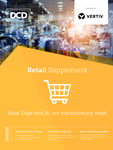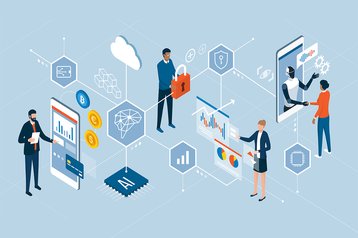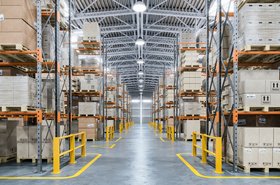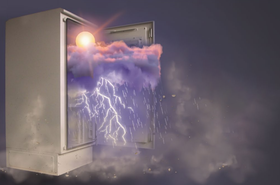The Edge is the past, present, and future of the retail industry. While the Covid-19 pandemic has shifted the model, in-store is typically where retailers make their money, store their goods, and engage with their customers.
“The retail edges are the things that drive the company's revenue and so it's very very important for them to make sure that they are able to drive revenue continuously, and not have any kind of downtime,” says Ezat Dayeh, senior systems engineer UK and Ireland at Cohesity.
But, as retailers look to adapt to the difficult commercial realities of Covid-19, the Edge is becoming an opportunity to consolidate old computing infrastructure to drive efficiency, but also embrace new high-data, low-latency use cases to improve customer experience.
Legacy Edge converging on new Edge
Stores have long been an Edge for the retail industry. Whether it’s CCTV for security, control and monitoring of freezers, or inventory management, each store has historically required some local compute capabilities. And while robots, machine learning, and autonomous stores garner much of the headlines, modern Edge computing is also being used as a way to centralize and increase the efficiency of legacy systems without moving everything to the cloud.
Cohesity’s Dayeh says that in recent years virtualization has allowed retailers to consolidate what might have been multiple pieces of hardware into one piece of physical infrastructure. Where once the Points of Sale (PoS), network management, routers, firewalls, transaction processing might all have needed dedicated hardware, these have all been virtualized and condensed into one unit. This will often come in the shape of a tower server or a 1U server attached to communications infrastructure at the location.
“It could be running a hypervisor with multiple VMs on there, they might even have a small cluster. I've seen some retailers have things like hyperconverged clusters of maybe three nodes,” he says.
However, as retailers look to evolve, they may move beyond consolidation and connect those Edge locations into a centrally-managed panel to drive greater efficiencies.
“We're seeing new applications being deployed at the Edge,” says Dave Demlow, VP of product strategy at Scale Computing. “Some of them are AI-related or customer experience related, but some of them are more of what I would consider mundane things they've always done, like video surveillance, but they’re now looking to kind of consolidate all this piecemeal IT infrastructure and treating remote Edge IT with a centralized management oversight.”
As the legacy Edge consolidates and retailers look to add new capabilities, the form factor for the infrastructure has to be reduced. Space is money in retail, and every inch that computing devices take up could to used to store or display stock.
“The smaller the better,” says Dayeh. “In an ideal world, they have zero footprint. Everything is run on the PoS machines themselves and they communicate directly over some form of WAN straight to a data center, for example.”
“We've had customers literally tell us this ‘needs to fit in between the bananas and the freezers,’” jokes Demlow.
Companies are also looking to simplify computing as much as possible, and many Edge computing firms are looking at offering compute devices that require as little configuration as possible so the on-site employees only need to plug in the power and Ethernet cables. The aim for many retailers is to reduce the on-site visits from IT staff as much as possible and enable more remote management.
A new hybrid infrastructure model for retail computing
The Edge has always been a part of the retail industry’s infrastructure model, but as the sector looks to stay ahead of competitors, the overall model is changing. Increasing use of AI and real-time supply-chains mean a hybrid model of Edge, cloud, and centralized data center is a common approach to accommodate data gravity and low-latency requirements.
“New applications are being written for hybrid Edge cloud operations,” says Demlow, “where they need at least that on-premise ability to collect data, perform transactions, but going to upload to a public cloud or a corporate data center for that centralized operations and processing.”
“We do see more retailers tend to look at a centralized data center versus going public cloud for that centralized piece where you aggregate things,” says Demlow, “But application providers are delivering software as a service and using the cloud components to deliver that.”
Another reason legacy Edge technologies are more likely to see themselves consolidated into smaller form factors than migrated entirely to the cloud is resilience. The Internet being down or being disconnected from the centralized data center doesn’t mean it’s OK for the store to stop working.
“Applications that are monitoring the freezer's temperature for compliance, those have to keep logging,” says Demlow. “If the Internet connection goes down, critical things like PoS have to keep going, video surveillance has to keep going, and you must ensure access control door locks work. That's usually the kind of the driving factor, because otherwise if you could put it in the cloud.”
“The worst thing you can do is have all these things in place and somebody walks into the store in an afternoon and our systems are down because the Internet connection is down, that's just not an acceptable answer in the retail space anymore.”
Future use cases to drive this hybrid model include smart shelves and digital signage for dynamic pricing, applying more machine vision to CCTV, and more in-store personalization. For retailers, the Edge becomes pivotal in collecting essential in-store information, processing it, sending the aggregated information home, and then receiving instructions back and relaying to the right devices at the right time.
“The Edge is becoming really really important in the pivotal point of all of the data transfer,” says Simon Pamplin, director of technical sales at Silverpeak. “Every bit of data has to go to the Edge, out to the cloud, or to a central location - and the intelligent Edge has to know what that traffic is and how to steer it.
“This is just the beginning of it. It will no longer be just devices that are going to be going through this Edge. There will be more integration to following the end-users so that we can give a better quality of experience to that particular user.”
What’s in store for in-store retail in 2021 and beyond?
An estimated 20,000 to 25,000 stores closed in the US in 2020, double the figure in 2019. While Covid-19 vaccines may be on the horizon, that trend will likely continue to accelerate. However, long term, the physical retail space looks likely to stick around even if it is less ubiquitous than in previous years.
In 2017, Farfetch CEO José Neves said brick and mortar accounted for 93 percent of sales and will still account for 80 percent by 2025.
Admittedly, the pandemic has likely accelerated a further shift away from physical retail but in-store sales are set to be around for a while yet, and what remains will likely be fewer massive retail spaces and more smaller, smarter boutique stores acting as drivers of online sales.
In its State of Retail in 2020 report, McKinsey noted a growing of retailers launching smaller ‘neighborhood’ or pop-up stores that offer personalized services and locally-relevant offerings where custom designs, highly-focused assortments, and experiential elements create more of a showroom than a full store with a whole range of products. The firm predicts retailers will need to utilize AI in order to create the right mix of tailored assortments for their local consumers.
“If I had a pop-up shop and I'm physically exhibiting some stuff, there could be some interesting capabilities around showing things using computers though and displays,” says Cohesity’s Dayeh. “Again having that centralized capability though means that I can update all of that on the fly and as and when customers come in they can see the latest version of that particular product.”
Cashierless checkouts in the shape of Amazon Go and its numerous competitors are set to grow. Juniper Research predicts that transactions using such smart technologies will reach $387 billion in 2025, up from just $2 billion in 2020. These stores will require much more computing at the Edge to process the large amount of data being ingested by machine vision and other autonomous technologies, before being aggregated and sent home to feed into what will need to be real-time supply chains.
“That's the ultimate retail where there are fully automated cashiers following you about the store and monitoring what goes into your basket,” says Silverpeak’s Pamplin. “That's almost taking technology to the nth degree of what we can do these days but it is the shape of things to come.”
At the same time, smart kiosks and lockers from vendors such as Amazon, Cleveron, or Luxor One offer a way for consumers to collect items from physical locations that suit them, whether in-stores, public buildings, or properties, in a self-service manner.
Again, these smaller locations need to be monitored, managed, and embedded with the rest of the company’s infrastructure in order to operate effectively. Retailers such as Uniqlo and Best Buy are investing in vending machines at similar locations to provide self-service shopping experiences and make them work.
As stores become smaller and smarter, retail firms will need to rethink how they approach what is processed at the Edge, what data is sent home, and what is sent to the cloud in order to serve customers that increasingly demand instant personalized services delivered to their doorsteps, neighborhoods, and screens.





